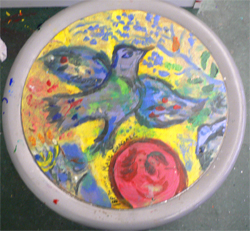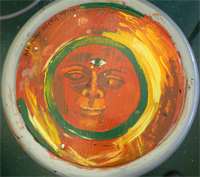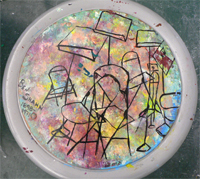 The 7th grade student, scanning a book, called out to her classmates, “Is anyone sitting on Frida?” Immediately a dozen pairs of eyes examined the classroom stools. “I am” came the reply. “What do you want to know?” The subject of interest was the painter Frida Kahlo and the student was studying how her life impacted her work.
The 7th grade student, scanning a book, called out to her classmates, “Is anyone sitting on Frida?” Immediately a dozen pairs of eyes examined the classroom stools. “I am” came the reply. “What do you want to know?” The subject of interest was the painter Frida Kahlo and the student was studying how her life impacted her work.
However bizarre this exchange may sound, it is actually commonplace for my students. In our art studio, every stool is painted to show a representation of work by a master artist along with important biographical bullet points. Truly, my students, whether in 1st grade or 8th grade learn ‘by the seat of their pants!’ Even parents drop by to do this kind of “research!”
When I first decorated the stools, I did it because it would be attractive and novel. I never expected that my efforts would be rewarded so soundly by an increase in student awareness, knowledge, and curiosity. I cannot explain why these decorated stools have translated into intense student learning. In fact, I cannot even say that I ever really see the kids doing anything other than sitting on them! Yet, year after year, the interest remains high.
My stools are painted with ordinary acrylic paint and coated with Mod Podge. I added the biographical details with black Sharpie marker. The paint has not dulled over time and I am able to sponge them clean.
 This same effect and the resulting benefits can be yours, even if you cannot put paint on your chairs. For seats that you cannot paint directly, you can decorate ordinary pieces of construction paper and adhere them to the seats with clear contact paper. It is critical that your designs or pictures be clear and that your penmanship be even and easy to read.
This same effect and the resulting benefits can be yours, even if you cannot put paint on your chairs. For seats that you cannot paint directly, you can decorate ordinary pieces of construction paper and adhere them to the seats with clear contact paper. It is critical that your designs or pictures be clear and that your penmanship be even and easy to read.
Although I am working with backless stools, you are more likely to be working with chairs. The back of a chair can be decorated on both sides. If painting the wood or metal is not an option, consider using a bag that slips over the back. You can purchase blank, canvas bags from Oriental Trading Company, Lakeshore Learning Stores or DharmaTrading.com. You can, if you like, cut off the handles. However, if you keep the handles intact, the bags can be stored on clothes hangers when not in use. You do not need elaborate supplies, just acrylic paint. (Tempera paint would work but is not washable.) Crayola fabric markers also will work for both your design and written information.
What if you are unable to paint anything recognizable? Do not worry. You can use photographs or pictures cut from magazines or books. Tacky Glue will stick these to fabric well. Given how entertaining this activity is, I imagine you would find it a simple task to encourage a parent, who needs volunteer hours, to accomplish this for you.
 Do not put a lot of information on the chair, only a few key points. This technique is potentially effective with Hebrew vocabulary, identifying key elements in parshiyot, biographies, Israeli geography and tefilla. It is designed to foster interest and pique curiosity, not to be a complete learning tool. You will be amazed by student engagement when you, in the course of a frontal lesson, ask which student is sitting on, or leaning back against, (fill in the blank).
Do not put a lot of information on the chair, only a few key points. This technique is potentially effective with Hebrew vocabulary, identifying key elements in parshiyot, biographies, Israeli geography and tefilla. It is designed to foster interest and pique curiosity, not to be a complete learning tool. You will be amazed by student engagement when you, in the course of a frontal lesson, ask which student is sitting on, or leaning back against, (fill in the blank).
The next time you walk into your classroom, view it through a totally new lens. Seriously consider the untapped potential of those ordinary, uninviting chairs.
With a bit of inspiration, good information and bright colors, your students will soon be learning ‘by the seat of their pants’ as well!

